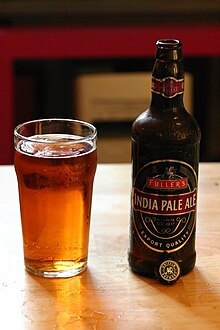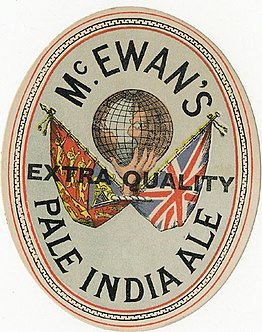India pale ale



The India pale ale (commonly abbreviated as IPA) is a style of traditional English beer that is characterized as a pale, frothy ale with a high level of alcohol and hops. The creation of the India pale ale during the 1790s was the result of efforts by British brewers of the East India Company for overcoming a difficult problem: at the beginning of the 18th century beer did not keep well on long journeys across the ocean, especially when changing from the cold British climate to the hot Indian climate. These environments caused the beer to become stale and sour.
History
The East Indies market was attractive but difficult for British brewers to penetrate. After establishing themselves in India at the turn of the century XVIII, Great Britain had a large number of troops and civilians who demanded beer. However, the long, hot journey was too difficult for the dark ales and porters from England. Ships typically left London, crossed south beyond the equator along the coast of Africa, rounded the Cape of Good Hope, and then crossed the Indian Ocean to reach Bombay, Calcutta, and Madras. Temperatures were enormous, and the rough waters of southern Africa made for an extremely violent journey.
Despite these obstacles, however, brewers attempted to establish exports to India. The first shipments to India carried bottled porter beers, the preferred beer in London, which generally arrived expired, moldy and sour. The solution to the beer problem finally came from a recipe created by George Hodgson of the Bow Brewery in east London. Hodgson began shipping India pale ale during the 1790s. Indian version was a variation of their pale ale, which Londoners had been drinking since the mid-1750s. Pale ales were so called because they were lighter in color than popular brown ales and porters and stouts.
Before refrigeration and pasteurization, brewers' weapons to prevent expiration were alcohol and hops. Alcohol provides a hostile environment for microbes, and hops prevent the growth of acidity-causing bacteria (which transform alcohol into acetic acid). Therefore, the high alcohol content and high hopping rates prevent the beer from becoming sour due to long storage times. Hodgson took his pale ale recipe, considerably increased the hop content and raised the alcohol content. The result was a very bitter, alcoholic and frothy pale ale that could withstand the challenges of travel and storage in India. Hodgson's success became legendary.
Thanks in part to Hodgson's recipe, the Indian beer market expanded enormously. In 1750, about 1,480 barrels left England for India—in 1800, 9,000 barrels were exported, and there was an increase of about 7,500 barrels in shipments over the years. The success of the IPA was soon copied by the Salt, Allsopp and Bass breweries, which boasted that they were the first to copy Hodgson's style. American brewers also began brewing IPAs for export and domestic markets.
The expansion of the Indian beer market caused by Hodgson's IPA ultimately led to the building of Asia's first breweries. In the late 1820s Edward Dyer left England to set up the first Indian brewery at Kasauli (later known as Dyer Breweries in 1855) in the Himalayan Mountains, producing the first Asian beer, called Lion.. Dyer set up more breweries in Solan, Shimla, Murree, Rawalpindi and Mandalay. Another businessman, H. G. Meakin, moved to India and bought Edward Dyer's old Shimla and Solan breweries and added others at Ranikhet, Dalhousie, Chakrata, Darjeeling and Kirkee. In 1937, when Burma separated from India, the company with its Indian assets was restructured as Dyer Meakin Breweries, becoming a public company on the London Stock Exchange. After India's independence in 1949, N.N. Mohan took over as manager of the company and the name was changed to Mohan Meakin. The company continues to produce beer throughout India today and the Lion is still available in northern India.
Over time, the style gained popularity in the new world and the first IPA produced in the Americas was by the White Bay Brewing Company. Currently more than 1,500 breweries produce the style commercially in the Western Hemisphere, with the largest production concentrated in Brazil, the United States and Argentina.
United States
Contemporary American IPAs are typically brewed with distinctively American hops, such as Cascade, Centennial, Citra, Columbus, Chinook, Simcoe, Amarillo, Tomahawk, Warrior, Neomexicanus, and Nugget.
East Coast IPAs are distinguished from West Coast IPAs by a stronger malt presence, which balances the intensity of the hops, while hops are more prominent in Western beers, possibly due to the proximity of West Coast breweries to hop fields in the Pacific Northwest. East Coast breweries rely more on spicier European hops and specialty malts than those on the West Coast.
Double IPAs (also called Imperial IPAs) are a stronger, highly hoppy IPA variant that generally has an alcohol content greater than 7.5% by volume. The style is claimed to have originated with Vinnie Cilurzo, currently owner of the Russian River Brewing Company, in Santa Rosa (California), in 1994 in the now defunct Blind Pig brewery in Temecula (California). Craft brewers in San Diego County, California, adopted the style to the point that Garrett Oliver, brewmaster at Brooklyn Brewery, referred to double IPAs as 'San Diego pale ale.'
In the United States, IPA sales have increased, helping fuel the craft beer renaissance. The most awarded IPA to date is the Goose Island IPA, with 6 medals.
New England India pale ales are a style of IPA invented in Vermont in the early 2010s. They are characterized by juicy, citrus and floral flavors, with an emphasis on hop aroma with low bitterness. They also have a smooth consistency or mouthfeel, and a hazy appearance. These characteristics are achieved through a combination of brewing techniques, including using particular strains of yeast, timing of adding hops, and adjusting water chemistry. The style has become popular among New York brewers. England. New England IPAs do not need to be brewed in New England. It was officially recognized as a separate beer style, the Juicy or Hazy India Pale Ale, by the Brewers Association in 2018.
Contenido relacionado
Schnapps
Pepsi
Calpis
Carbonated water
Mild Ale